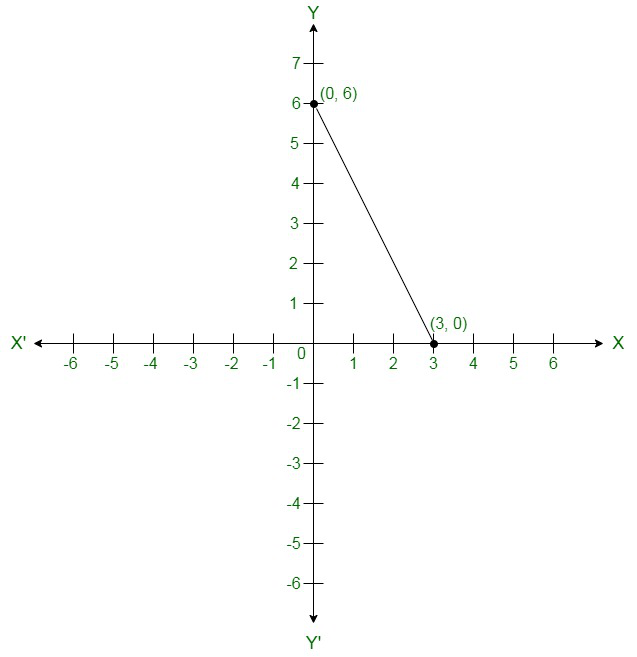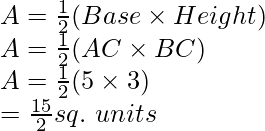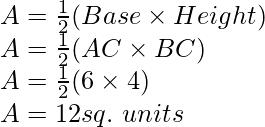Given:
2x + 3y = 12
We get,

Substituting x = 0 in y =  we get,
we get,

y = 4
Substituting x = 6 in  , we get
, we get

y = 4
Hence, we have the following table exhibiting the abscissa and ordinates of points on the line represented by the given equation

By plotting the given equation on the graph, we get the point B (0, 4) and C (6,0).
(i) Co-ordinates of the point whose y axis is 3 are A 
(ii) Co-ordinates of the point whose x -coordinate is –3 are D (-3, 6)
(i) Given:
6x – 3y = 12
We get,

Now, substituting x = 0 in  , we get
, we get
y = -4
Substituting x = 2 in  , we get
, we get
y = 0
Hence, we have the following table exhibiting the abscissa and ordinates of points on the line represented by the given equation

Co-ordinates of the points where graph cuts the co-ordinate axes are at y = -4 axis and x = 2
at x axis.
(ii) Given:
-x + 4y = 8
We get,

Now, substituting x = 0 in  , we get
, we get
y = 2
Substituting x = -8 in  , we get
, we get
y = 0
Hence, we have the following table exhibiting the abscissa and ordinates of points on the line represented by the given equation

Co-ordinates of the points where graph cuts the co-ordinate axes are at y = 2 axis and x = -8
at x axis.
(iii) Given:
2x + y = 6
We get,
y = 6 – 2x
Now, substituting x= 0 in y = 6 – 2x w e get
y = 6
Substituting x = 3 in y = 6 – 2x, we get
y = 0
Hence, we have the following table exhibiting the abscissa and ordinates of points on the line represented by the given equation

Co-ordinates of the points where graph cuts the co-ordinate axes are y = 6 at y axis and x = 3
at x axis.
(iv) Given:
3x + 2y + 6 = 0
We get,

Now, substituting x = -2 in  , we get
, we get
y = -3
Substituting x = -2 in  , we get
, we get
y = 0
Hence, we have the following table exhibiting the abscissa and ordinates of points on the line represented by the given equation

Co-ordinates of the points where graph cuts the co-ordinate axes are y = -3 at y axis and x = -2
at x axis.
Given:
2x + y = 6
We get,
y = 6 – 2 x
Now, substituting x = 0 in y = 6 – 2x ,we get
y = 6
Substituting x = 3 in y = 6 – 2x ,we get
Hence, we have the following table exhibiting the abscissa and ordinates of points on the line represented by the given equation

The region bounded by the graph is ABC which forms a triangle.
AC at y axis is the base of triangle having AC = 6 units on y axis.
BC at x axis is the height of triangle having BC = 3 units on x axis.
Therefore,
Area of triangle ABC, say A is given by

A = 9 sq. units
Given:

4x + 3y = 12
We get,

Now, substituting x = 0 in  , we get
, we get
y = 4
Substituting x = 3 in  , we get
, we get
y = 0
Hence, we have the following table exhibiting the abscissa and ordinates of points on the line represented by the given equation

The region bounded by the graph is ABC which form a triangle.
AC at y axis is the base of triangle having AC = 4 units on y axis.
BC at x axis is the height of triangle having BC = 3 units on x axis.
Therefore,
Area of triangle ABC, say A is given by

A = 6 sq. units
We are given,
y = |x|
Substituting, x = 1 we get
y = 1
Substituting, x = -1 we get
y = 1
Substituting,x = 2 we get
y = 2
Substituting, x = -2 we get
y = 2

For every value of x, whether positive or negative, we get y as a positive number.
Given:
y = |x| + 2
Substituting, x = 0 we get
y = 2
Substituting, x = 1 we get
y = 3
Substituting, x = -1 we get
y = 3
Substituting, x = 2 we get
y = 4
Substituting, x = -2 we get
y = 4

For every value of x, whether positive or negative, we get y as a positive number and the minimum value of y is equal to 2 units.
Given:
2x + 3y = 12
We get,

Now, substituting x = 0 in  , we get
, we get
y = 4
Substituting x = 6 in  , we get
, we get
y = 0
Therefore, we have the following table exhibiting the abscissa and ordinates of points on the line represented by the given equation
Plotting A(0,4) and E(6,0) on the graph and by joining the points , we obtain the graph of equation .
Given:
x – y = 1
We get,
y = x − 1
Now, substituting x = 0 in y = x − 1,we get
y = −1
Substituting x = -1 in y = x − 1,we get
y = −2
Therefore, we have the following table exhibiting the abscissa and ordinates of points on the line represented by the given equation
Plotting D(0,1) and E(-1,0) on the graph and by joining the points , we obtain the graph of equation .

By the intersection of lines formed by 2x + 3y = 12 and x – y = 1 on the graph, triangle ABC is formed on y axis.
Therefore,
AC at y axis is the base of triangle ABC having AC = 5 units on y axis.
Draw FE perpendicular from F on y axis.
FE parallel to x axis is the height of triangle ABC having FE = 3 units on x axis.
Therefore,
Area of triangle ABC, say A is given by

Given:
4x – 3y + 4 = 0
We get,

Now, substituting x = 0 in  , we get
, we get

Substituting x = -1 in  , we get
, we get
y = 0
Hence, we have the following table exhibiting the abscissa and ordinates of points on the line represented by the given equation
| x | 0 | -1 |
| y |  | 0 |
Plotting E(0,  ) and A(-1,0) on the graph and by joining the points, we obtain the graph of equation.
) and A(-1,0) on the graph and by joining the points, we obtain the graph of equation.
We are given,
4x + 3y – 20 = 0
We get,

Now, substituting x = 0 in  , we get
, we get

Substituting x = 5 in  , we get
, we get
y = 0
Therefore, we have the following table exhibiting the abscissa and ordinates of points on the line represented by the given equation
| x | 0 | 5 |
| y |  | 0 |
Plotting D(0,  ) and B(5,0) on the graph and by joining the points, we obtain the graph of equation.
) and B(5,0) on the graph and by joining the points, we obtain the graph of equation.

By the intersection of lines formed by 4x – 3y + 4 = 0 and 4x + 3y – 20 = 0 on the graph, triangle ABC is formed on x axis.
Therefore,
AB at x axis is the base of triangle ABC having AB = 6 units on x axis.
Draw CF perpendicular from C on x axis.
CF parallel to y axis is the height of triangle ABC having CF = 4 units on y axis.
Therefore,
Area of triangle ABC, say A is given by

Given: Path of train A,
3x + 4y – 12 = 0
We get,

Now, substituting x = 0 in  ,we get
,we get
y = 3
Substituting x = 4 in  ,we get
,we get
y = 0
Therefore, we have the following table exhibiting the abscissa and ordinates of points on the line represented by the given equation
Plotting A(4,0) and E(0,3) on the graph and by joining the points , we obtain the graph of equation .
We are given the path of train B,
6x + 8y – 48 = 0
We get,

Now, substituting x = 0 in  ,we get
,we get
y = 6
Substituting x = 8 in  ,we get
,we get
y = 0
Therefore, we have the following table exhibiting the abscissa and ordinates of points on the line represented by the given equation
Plotting C(0,6) and D(8,0) on the graph and by joining the points , we obtain the graph of equation.

We are given the present age of Ravish as y years and Aarushi as x years.
Age of Ravish seven years ago = y – 7
Age of Aarushi seven years ago = x – 7
It has already been said by Ravish that seven years ago he was seven times old then Aarushi was then
So,
y – 7 = 7(x – 7)
y – 7 = 7x – 49
7x – y = -7 + 49
7x – y – 42 = 0
Age of Ravish three years from now = y + 3
Age of Aarushi three years from now = x + 3
It has already been said by Ravish that three years from now he will be three times old then Aarushi will be then
So,
y + 3 = 3(x + 3)
y + 3 = 3x + 9
3x + 9 – y – 3 = 0
3x – y + 6 = 0
(1) and (2) are the algebraic representation of the given statement.
Given:
7x – y – 42 = 0
We get,
y = 7x – 42
Now, substituting x = 0 in y = 7x – 42 ,we get
y = -42
Substituting x = 6 in y = 7x – 42, we get
y = 0
Therefore, we have the following table exhibiting the abscissa and ordinates of points on the line represented by the given equation
Given:
3x – y + 6 = 0
We get,
y = 3x + 6
Now, substituting x = 0 in y = 3x + 6 ,we get
y = 6
Substituting x = -2 in y = 3x + 6 ,we get
y = 0
Therefore, we have the following table exhibiting the abscissa and ordinates of points on the line represented by the given equation

The red -line represents the equation. 7x – y – 42 = 0
The blue-line represents the equation. 3x – y + 6 = 0
Aarushi is driving the car with the uniform speed of 60 km/h.
We represent time on X-axis and distance on Y-axis
Now, graphically

We are given that the car is travelling with a uniform speed 60 km/hr. This means car travels 60 km distance each hour. Thus the graph we get is of a straight line.
Also, we know when the car is at rest, the distance traveled is 0 km, speed is 0 km/hr and the time is also 0 hr.
Therefore, the given straight line will pass through O(0,0) and M(1,60).
Join the points O and M and extend the line in both directions.
Now, we draw a dotted line parallel to y-axis from x =  that meets the straight line graph at L from which we draw a line parallel to x-axis that crosses y-axis at 30. Thus, in
that meets the straight line graph at L from which we draw a line parallel to x-axis that crosses y-axis at 30. Thus, in  hr, distance traveled by the car is 30 km.
hr, distance traveled by the car is 30 km.
Now, we draw a dotted line parallel to y-axis from x =  that meets the straight line graph at N from which we draw a line parallel to x-axis that crosses y-axis at 150. Thus, in
that meets the straight line graph at N from which we draw a line parallel to x-axis that crosses y-axis at 150. Thus, in  hr, distance traveled by the car is 150 km.
hr, distance traveled by the car is 150 km.
(i) Distance = Speed × Time
Distance traveled in  hours is given by
hours is given by
Distance = 
Distance = 
Distance = 150 km
(ii) Distance = Speed × Time
Distance traveled in  hours is given by
hours is given by
Distance = 
Distance = 30 km